Physical Address
304 North Cardinal St.
Dorchester Center, MA 02124
Cardiac tumors, benign and malignant types, are uncommon, with an incidence of 0.002% to 0.3% on autopsy series. However, even benign cardiac tumors may present with significant obstructive symptoms or be a substrate for arrhythmias. Tumors in the left side of the heart have the potential to cause systemic or neurologic embolic phenomena. The goals of imaging in cardiac masses are as follows:
Anatomic localization of the mass, which may sometimes provide a clue to the specific diagnosis
Tissue characterization
Distinction from thrombi, other non-neoplastic benign entities, and anatomic variants
Conventional radiographs are rarely useful in evaluating cardiac masses, unless the lesions are big or lead to cardiomegaly. Imaging evaluation of cardiac masses usually begins with echocardiography and, because it is so widely used, cardiac masses are often discovered incidentally on echocardiography. However echocardiography has its limitations; it is operator dependent and may be limited by acoustic windows—for example, in large patients and those with chronic obstructive pulmonary disease.
Computed tomography (CT) has a significant role in evaluating cardiac masses in view of high spatial acquisition and the ability to acquire multiplanar data rapidly. Its ability to characterize fat and calcium accurately may help narrow the differential diagnosis in some cases. MRI, with its high tissue contrast resolution and multiplanar imaging, is often the modality of choice for evaluating cardiac masses. The MRI planes may need to be tailored to a specific mass location. A standard protocol for the evaluation of cardiac masses begins with scout images, followed by steady-state free precession (SSFP) images in standard planes (paraseptal or vertical long-axis, horizontal long-axis, short-axis stack, three-chamber views). T1 axial fast spin-echo images, without—and, if needed, with—fat suppression should be performed in planes best suited to evaluate the mass in question. T2-weighted images are obtained to evaluate edema or T2 characteristics of the mass. Tagging may be useful in masses that infiltrate the myocardium or involve the pericardium. First-pass perfusion images, acquired during gadolinium administration, are useful to evaluate vascularity of the mass. Delayed gadolinium images at 8 to 15 minutes are acquired in a short-axis view to cover the left ventricle and in any additional planes that may be necessary to show the mass. In between the perfusion images and delayed gadolinium images, fast spin-echo, postcontrast T1 images may be obtained in optimal planes, which are determined by the location of the mass.
Among primary cardiac tumors, 90% are benign and, of these, the most common are myxomas (50%–80%). They are three times more common in females than males and usually present in the fourth to sixth decades of life. In 60% to 80% of cases, myxomas are seen in the left atrium ( Fig. 32.1 ), in the region of the interatrial septum and fossa ovalis, followed by the right atrium (15%–28%), right ventricle (8%; Fig. 32.2 ), left ventricle (3%–5%), and, rarely, the valves. About 10% of these are biatrial, often extending via the fossa ovalis from the left atrium to the right.
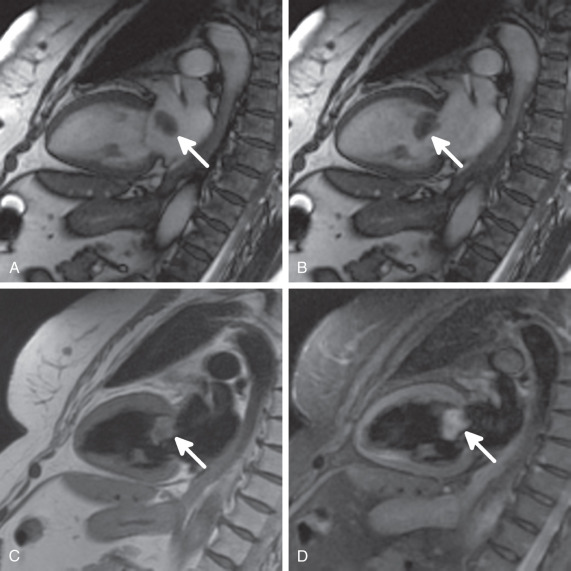
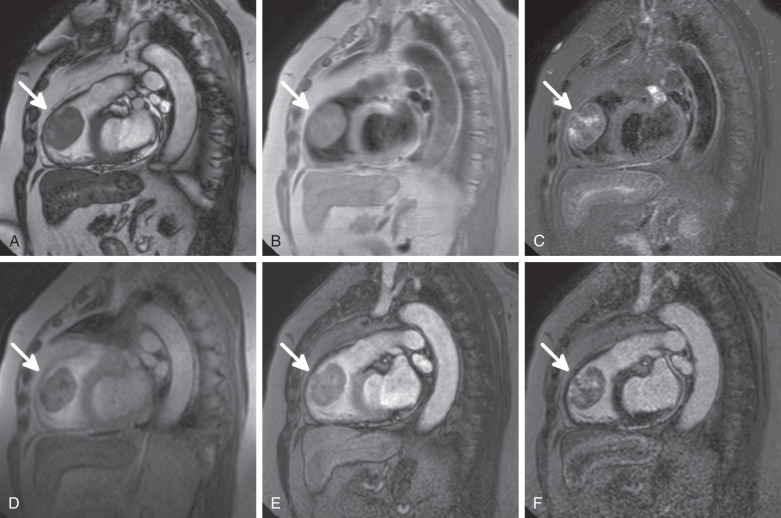
Most myxomas occur sporadically, but approximately 7% occur syndromically, with the Carney complex, an X-linked autosomal dominant syndrome consisting of cardiac and extracardiac myxomas, spotty skin pigmentation, endocrine overactivity, and schwannomas. Myxomas associated with the Carney complex occur in younger patients, who are more likely to be male, and tend to recur after resection. Recent studies have shown that both sporadic myxomas and those associated with the Carney complex may have a mutation in the PRKAR1A gene, suggesting a plausible genetic origin for at least some of these tumors.
Clinically, approximately, 10% to 15% of myxomas are asymptomatic at the time of diagnosis. Alternatively, they may present with systemic constitutional symptoms due to interleukin production or obstructive symptoms related to left and right heart failure. A large, mobile, left atrial myxoma may prolapse through the mitral valve, causing functional mitral obstruction, or a so-called wrecking ball effect due to back and forth prolapse of the tumor through the mitral valve. Embolic manifestations are seen in 30% to 50% of myxomas and usually involve the cerebral and retinal circulations.
Pathologically, myxomas are rounded lobular masses, with a bosselated surface. Cystic forms of myxoma have been reported. One-third of myxomas are calcified, and some may demonstrate hemorrhage. On gross pathology, one-third of myxomas are papillary, and the remaining are polypoidal. The papillary myxomas are the ones more likely to present with neurologic and systemic embolic events due to detached fragments, whereas the polypoidal types are more likely to present with obstructive symptoms. Right atrial myxomas are more likely to be calcified than left atrial myxomas.
Myxomas are heterogeneously low attenuating on CT, usually demonstrating lower or, less frequently, equal enhancement to that of the surrounding myocardium. Calcification, if present, is well seen on CT, usually visualized as a coarse or punctate calcification, and is more common in right atrial myxomas but uncommon in left atrial myxomas. Atrial myxomas have a narrow attachment to the interatrial septum.
On MRI, myxomas are typically isointense on T1-weighted images and hyperintense on T2-weighted sequences. Balanced SSFP images demonstrate the mobility of atrial myxomas (see Fig. 32.1 ), which may prolapse through the atrioventricular valves, causing temporary obstruction. On the balanced SSFP images, myxomas are generally hypointense compared to the blood pool and hyperintense to the normal myocardium. On early first-pass images, they may show no or mild enhancement; demonstrating a greater degree of heterogenous enhancement on late gadolinium enhancement sequences, performed 10 to 15 minutes after contrast enhancement. Heterogeneity on postcontrast images is related to areas of necrosis, hemorrhage, fibrosis, and calcification (see Fig. 32.2 ).
Cardiac lipomas are the second most common primary tumors of the heart. They may occur anywhere and usually present at a young age. They are well-encapsulated lesions, made up of mature adipocytes; about 50% are subepicardial and midmyocardial in origin, and the remaining 50% are subendocardial in location. Lipomas may occur sporadically in the heart or in association with tuberous sclerosis. Lipomas are usually discovered incidentally and are asymptomatic but, depending on their size, may grow large enough to cause coronary artery or pericardial compression (subepicardial), arrhythmias (intramyocardial), or outflow obstruction (subendocardial).
On CT and MRI, they follow the typical appearance of fat-containing tissues—that is, low density on CT and bright on T1 MRI sequences—and are suppressed with the application of fat saturation (or suppression) pulses. A useful additional clue is the similar signal intensity of the surrounding mediastinal or chest wall fat on CT, as well as T1- and T2-weighted sequences. Lipomas are avascular and do not enhance with contrast ( Fig. 32.3 ).
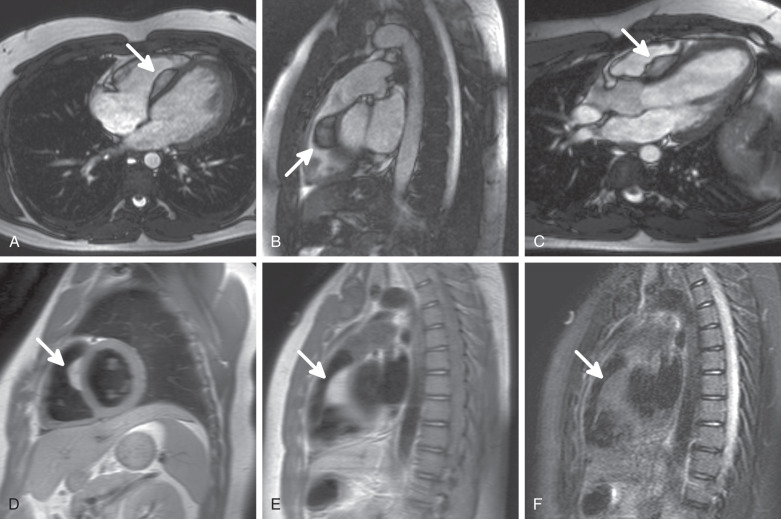
Cardiac lipomas need to be distinguished from lipomatous hypertrophy of the interatrial septum, which is often seen in older and overweight patients. In contrast to lipomas, these typically involve the interatrial septum, with sparing of the fossa ovalis, creating a typical dumbbell appearance ( Fig. 32.4 ). The presence of metabolically active brown fat in this entity may cause it to be metabolically active on positron emission tomography scans.

Cardiac fibromas are the second most common congenital tumor and usually present in pediatric or young adult life. They have a propensity to involve the ventricles, left more often than the right. They are typically well circumscribed and may be centrally calcified. It is the most common resected cardiac neoplasm in children and the second most common benign primary tumor found at autopsy in children. Prevalence among males and females is equal. Syndromic cardiac fibromas occur in association with Gorlin syndrome, an autosomal dominant condition associated with multiple basal cell carcinomas, jaw cysts, skeletal anomalies, and a tendency to develop neoplasms in several organ systems.
Most of the cardiac fibromas are solitary and usually occur in the interventricular septum or ventricular free wall. Central dystrophic calcification is best identified by CT. On MRI, these lesions are isointense to hyperintense on T1-weighted sequences and slightly hypointense on T2-weighted images. On delayed postgadolinium images, they may either demonstrate intense enhancement or a central hypointense area with a well-demarcated, isointense surrounding shell ( Figs. 32.5 and 32.6 ).
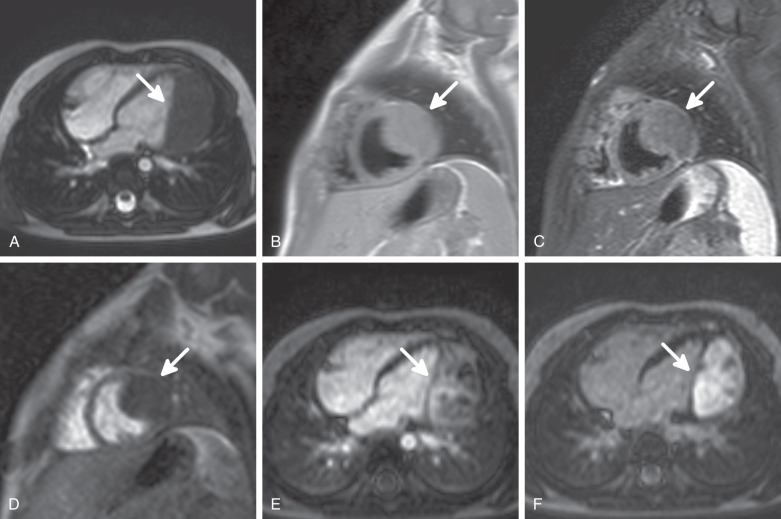
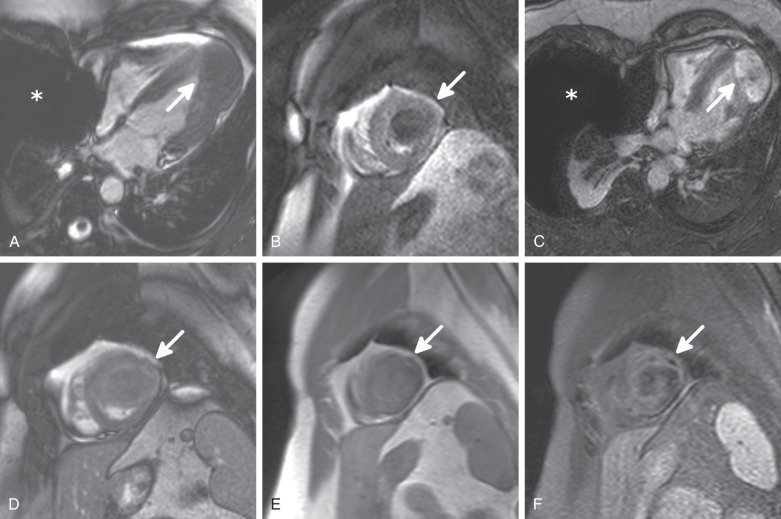
Rhabdomyomas are the most common primary tumors in children. They usually present in the first year of life. Rhabdomyomas demonstrate a high association with tuberous sclerosis, with about 60% to 80% of cardiac rhabdomyomas associated with tuberous sclerosis, and over 50% of patients with tuberous sclerosis having rhabdomyomas. Multiplicity of lesions has an even higher association with tuberous sclerosis. They are well-circumscribed lesions, ranging from a few millimeters to a few centimeters in size. Histologically, they are hamartomas. They arise intramurally in the ventricular myocardium. Most rhabdomyomas regress spontaneously by the age of 4 years, and surgical removal is reserved for symptomatic lesions causing obstruction.
Rhabdomyomas are often diagnosed on antenatal ultrasound, where they are hyperechoic. They are generally isointense to the surrounding myocardium on T1-weighted images and hyperintense on T2-weighted sequences (unlike fibromas). They typically show no significant or only minimal early gadolinium enhancement and are isointense on delayed enhanced sequences.
Hemangiomas are vascular tumors that account for 5% to 10% of all cardiac tumors. Histologically they may be cavernous, capillary, arteriovenous, or usually mixed.
On cardiac MR images, hemangiomas are typically heterogeneous and hyperintense on T1- and T2-weighted images due to slow blood flow and show intense postcontrast enhancement due to their high vascular content, but there may be regions of inhomogeneity due to calcification and fibrous septa ( Figs. 32.7 and 32.8 ).
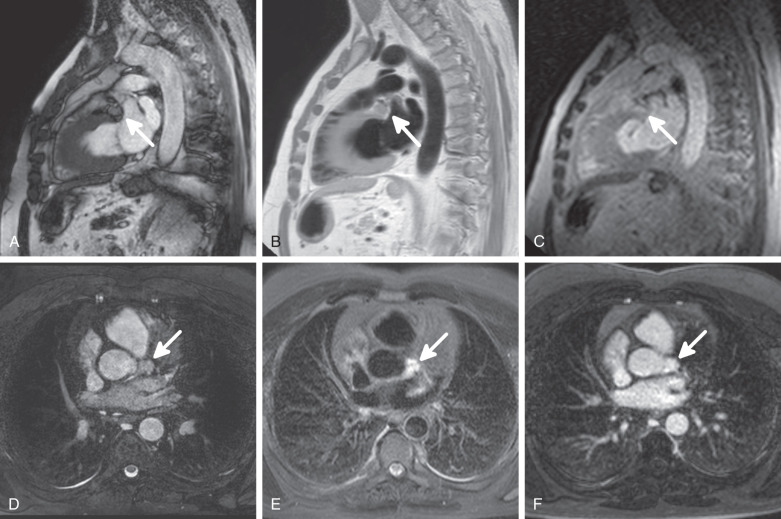
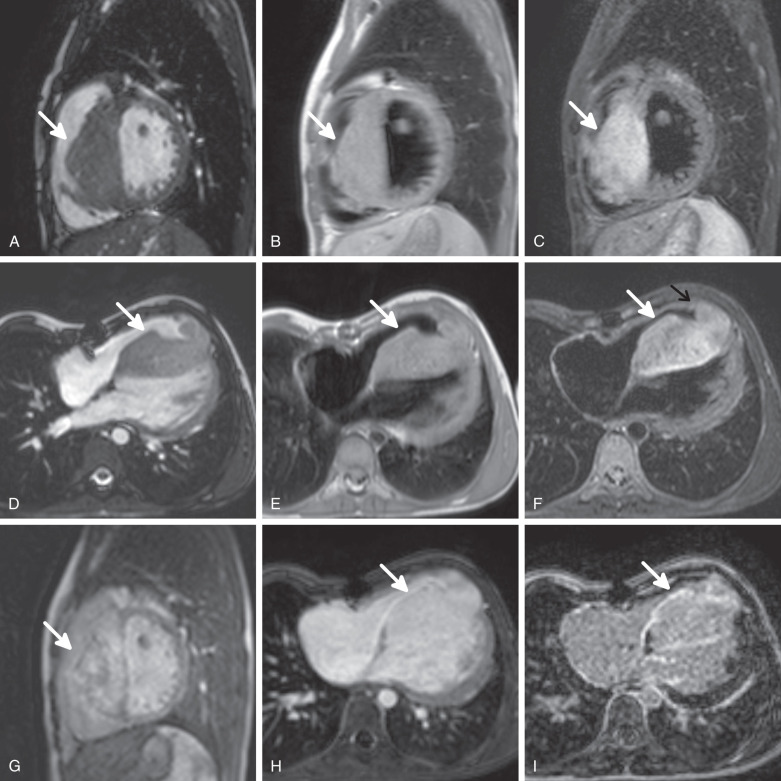
Become a Clinical Tree membership for Full access and enjoy Unlimited articles
If you are a member. Log in here